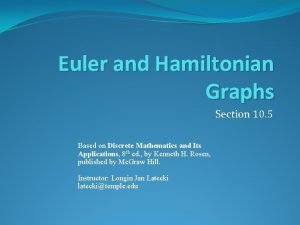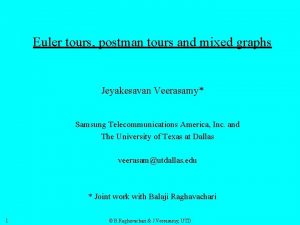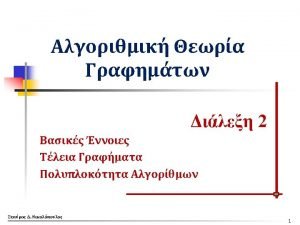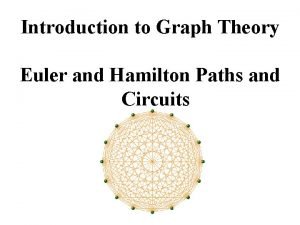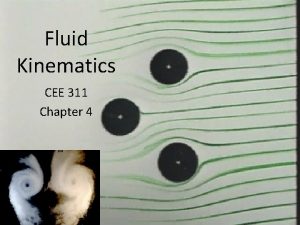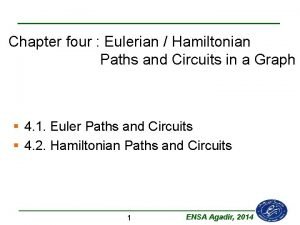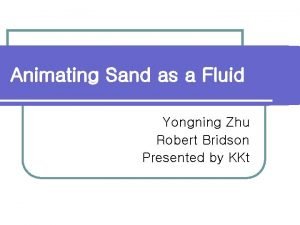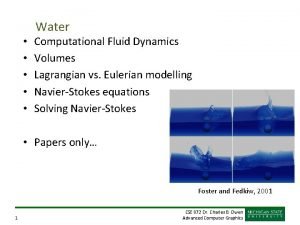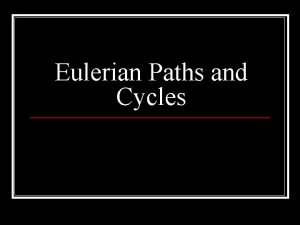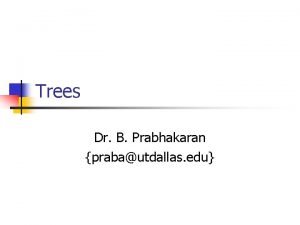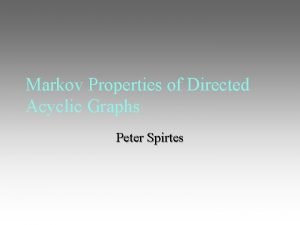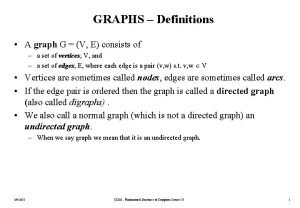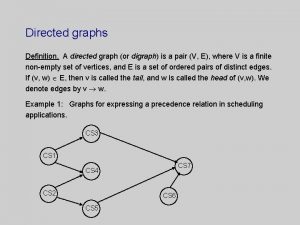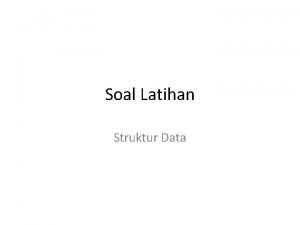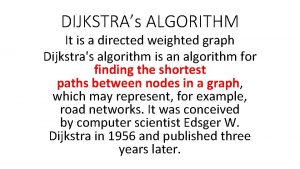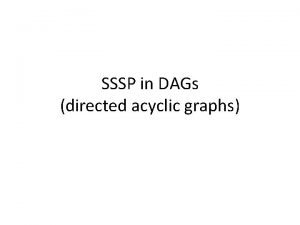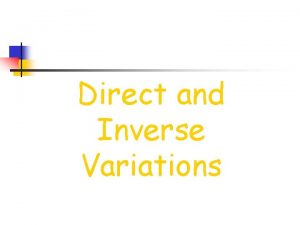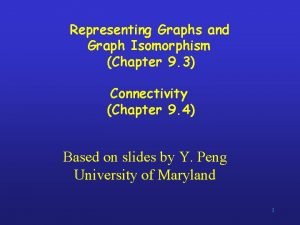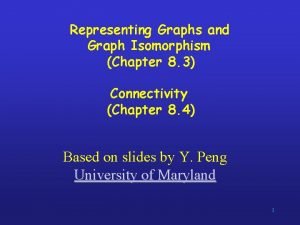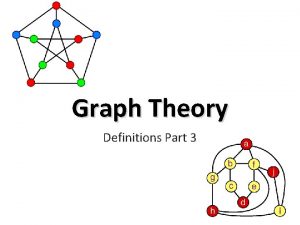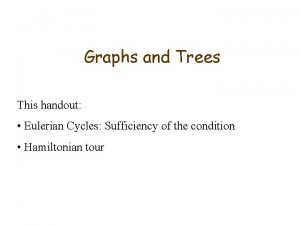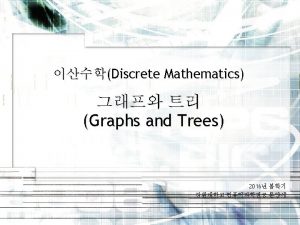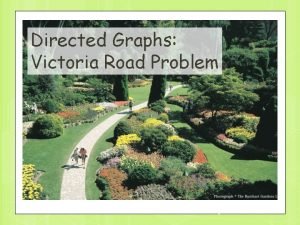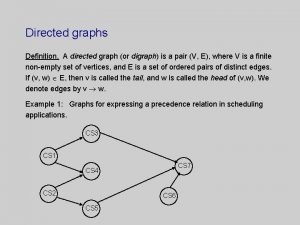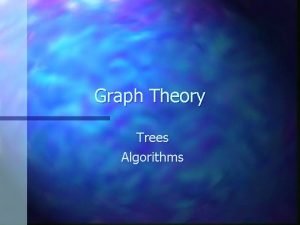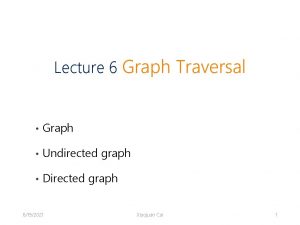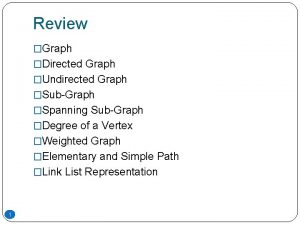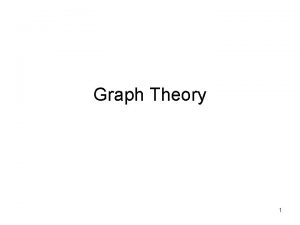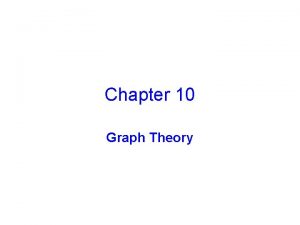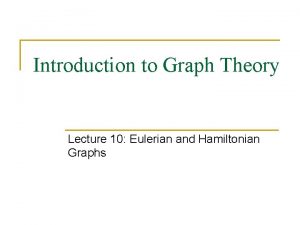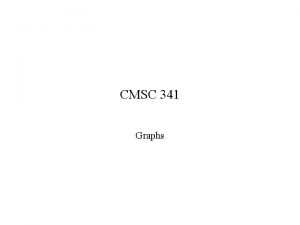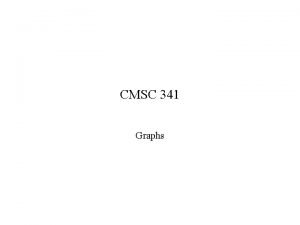GRAPH THEORY Definitions Trees cycles directed graphs Eulerian































- Slides: 31

GRAPH THEORY Definitions Trees, cycles, directed graphs. Eulerian, Hamiltonian Graphs. Special graphs

Graphs and Multigraphs A graph consists of two things: 1) A set V whose elements are called vertices, points, or nodes. 2) A set E of unordered pairs of distinct vertices called edges. We denote such a graph by G(V, E) when we want to emphasize the two parts of a G. Vertices u and v are said to be adjacent if there is an edge {u, v}.

Multi graphs • Loop – an edge that has the same vertex at each end • Multi-edge – and edge that has the same two endpoints as another edge • Multi-graph – a graph that contains at least 1 loop or multiedge. Example Blue – loops Red - multi edges Black – standard edges

Subgraphs • Let G(V, E) be a graph. • Let V’ be a subset of V and E’ is a subset of E whose endpoints belong to V’. • Then G(V’, E’) is a subgraph of G(V, E)

Degree of a vertex deg(v) • If v is an endpoint of an edge e, then we say that e is incident on v. • The degree of a vertex deg(v) is the number of edges which are incident on v. • The graph below has vertices labeled with their degree.

Connectivity •

Connected components of G(V, E) •

Connected components of G(V, E) A cut point is a vertex where if removed from a Graph G(V, E) (which would consequentially remove all attached edges) would disconnect the graph.

Distance/diameter in connected Graphs Distance between vertices u and v of a connected graph G, written d(u, v) is the length of the shortest path from u to v. The diameter of a connected component is the maximum distance between any two of its vertices

Bridges of Konigsberg Question: Beginning anywhere can a person walk over each bridge exactly once? Legend has it that Euler answered the question.

Bridges of Konigsberg – traversable • Such a walk must be a trail since no bridge can be used twice. • A graph is said to be traversable is it can be drawn without any breaks in the curve and without repeating any edge, that is, if there is a walk which includes all vertices and uses each edge exactly once.

Bridges of Konigsberg – Side facts •

Bridges of Konigsberg – solved • Since the graph has more than 2 odd degree vertices, it can not be traversed. Euler gets credit for solving this.

Eulerian Graph • A finite connected graph is Eulerian if and only if each vertex has even degree • Any graph with 2 odd degree vertices is traversable.

Hamiltonian Graphs • Hamiltonian Cycle is a closed (start and end vertices are the same) walk which includes every vertex exactly once. • Such a walk must be a cycle and is called a Hamiltonian Cycle. • Any graph that contains Hamiltonian cycle is a Hamiltonian Graph. • A path that visits every vertex exactly once is a Hamiltonian Path Ham-Cycle Ham-Path

Special Graphs – k regular • A graph is k-regular if every vertex has degree k

Special Graphs - Bipartite • If a Graph G(V, E) can have it’s vertices in V partitioned into 2 disjoint sets such that every edge in E connects vertices from one set to the other set, then that graph is said to be bipartite.

Special Graphs - Trees • A cycle is a closed walk over a subset of vertices where no edge is traversed more than once. • A graph is said to be cycle-free or acyclic if it has no cycles. • A connected graph with no cycles is said to be a tree

Special Graphs - Labeled • A graph G is said to be labeled if it edges and/or vertices are assigned data of one kind or another. • Generally, if edges are assigned a non-negative value it is called the edge’s weight. • Weighted labeled graph

Special Graphs - Isomorphic • Two graphs are isomorphic to each other if there is a one- to-one correspondence of vertices and the vertices they are connected to.

Special Graphs – Rooted Tree • A tree with one special vertex called the root • Internal vertex – vertices that are connected to another vertex that is further from the root than itself • Leaf vertex – a vertex that is further from the root that any vertex it is adjacent to.

Special Graphs - Planar • A graph or multi-graph that can be drawn on a plane without any edges crossing each other is a planar graph. • Planar

Special Graphs – Maps and Regions •

Euler’s formula V–E+R=2 Proof by induction: • Take an existing graph and re build it from scratch • All graphs start with a vertex 1 - 0 + 1 = 2 holds • Repeatedly add edges connected to existing vertices. • Each edge will connect to an existing vertex or introduce a new vertex • If connecting to an existing vertex: E and R each increment • If connecting to a new vertex: V and E each increment

Special Graphs – Colored • A vertex coloring or simply coloring, of a graph G is an assignment of colors to the vertices of G such that adjacent vertices have different colors. We say that G is ncolorable if there exists a coloring of G which uses n colors. • 4 -coloring for the graph

Converting Regions to Vertices • If a graph is planar, we can create a corresponding graph that maps regions to vertices. Edges are added to show regions that border on each other.

Special Graphs – Directed • A graph G is a directed graph if the edges have orientations.

Spanning Tree of a Graph • If G(V, E) is a connected graph, the G(V, E’) if a Spanning Tree if G(V, E’) is connected and contains no cycles. • A graph can have many spanning trees. • For weighted graphs, the spanning tree(s) with the minimum total weight is called Minimum Spanning Tree (MST)

Vertex Cover of a Graph • If G(V, E) is a connected graph, the G(V’, E) if a Vertex Cover (VC) if every edge is connected to a vertex in V’. • A graph can have many vertex covers. • Of all vertex covers, the one with the lowest |V’| is the minimum vertex cover.

Representing Graphs in Memory • Adjacency matrix

Representing Graphs in Memory • Adjacency lists
 Euler graph
Euler graph Eulerian graph properties
Eulerian graph properties Math graph
Math graph Syntax of mkleaf is
Syntax of mkleaf is Algorithmic graph theory and perfect graphs
Algorithmic graph theory and perfect graphs Euler
Euler Euler
Euler Eulerian description of fluid flow
Eulerian description of fluid flow Euler path vs circuit
Euler path vs circuit Eulerian vs lagrangian
Eulerian vs lagrangian Animating pictures with eulerian motion fields
Animating pictures with eulerian motion fields Graf complet
Graf complet Eulerian vs lagrangian fluids
Eulerian vs lagrangian fluids Fluids equation
Fluids equation Eulerian paths
Eulerian paths Which of the following graphs are trees
Which of the following graphs are trees State testing and testability tips
State testing and testability tips Graphs that compare distance and time are called
Graphs that compare distance and time are called Graphs that enlighten and graphs that deceive
Graphs that enlighten and graphs that deceive Polynomial end behavior chart
Polynomial end behavior chart Properties of directed acyclic graph
Properties of directed acyclic graph G ve
G ve Definition of directed graph
Definition of directed graph Dari gambar ini notasi prefix yang dihasilkan adalah
Dari gambar ini notasi prefix yang dihasilkan adalah Directed weighted graph
Directed weighted graph Dag directed acyclic graph
Dag directed acyclic graph Line graph graph theory
Line graph graph theory Game theory and graph theory
Game theory and graph theory Euler
Euler Inverse cariation
Inverse cariation Representing graphs and graph isomorphism
Representing graphs and graph isomorphism Representing graphs and graph isomorphism
Representing graphs and graph isomorphism
